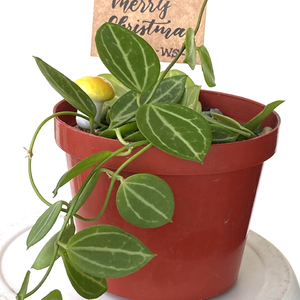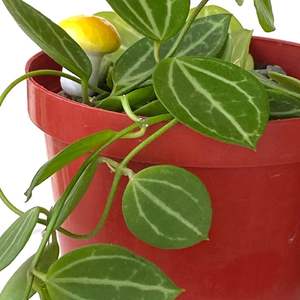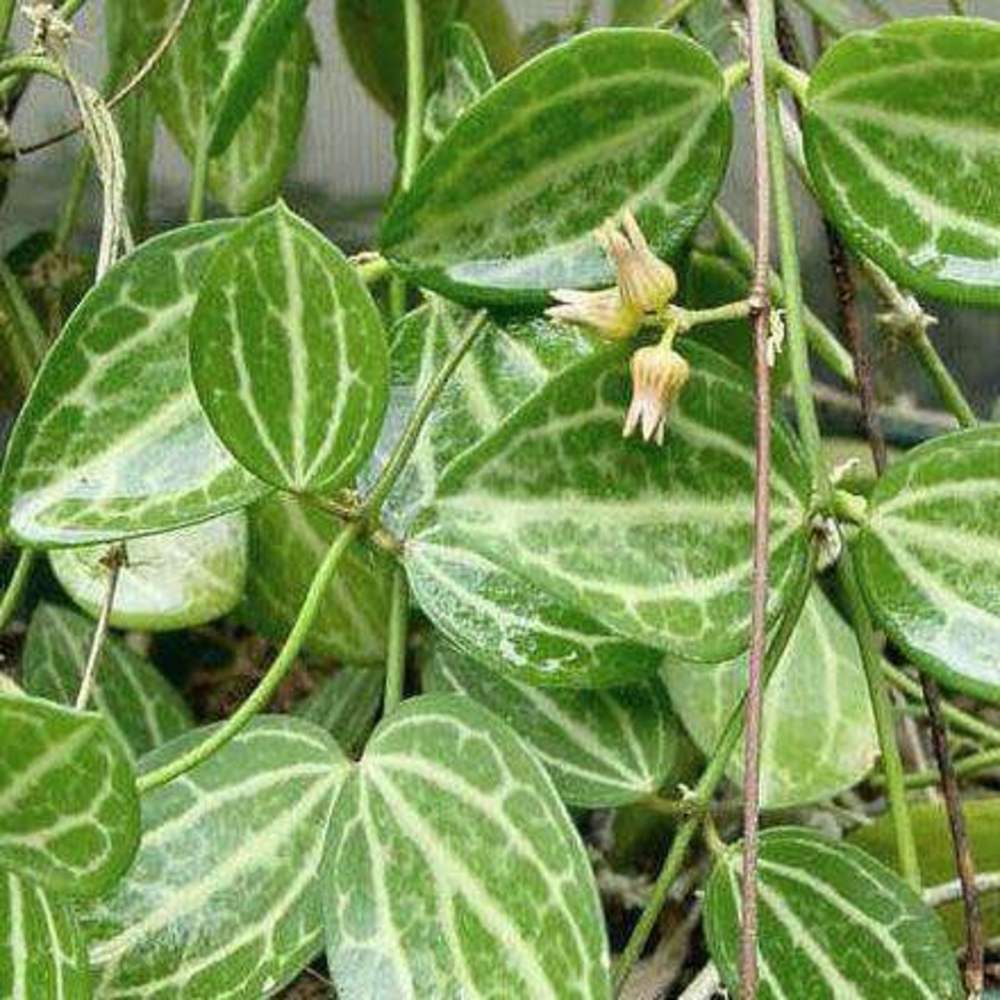Plant Experience
Detail
These adorable little cousins to the Hoya have nice trailing vines with pretty leaves that leave little question how the Dischidia ovata earned its common name of Watermelon Dischidia. These smaller oval shaped leaves are a pretty shade of green with white stripes that somewhat resemble a watermelon. The quite small, dainty flowers are a green-yellow with purple lines. They add a little bit of a unique flare to any house plant collection with their distinct leaves and are sure to grab attention!
Lighting
As it would be in its native rainforest canopy environment, Dischidia ovata thrives in bright, dappled sunlight. Under intense sunlight the leaves can turn red, which is often considered to be a symptom of heat stress – so that’s potentially a signal to move it to a shadier spot.
Watering
The Watermelon Dischidia is a tropical plant and so it does likes regular moisture, however it’s also an epiphyte. So, it’s used to growing on trees and branches above the ground, and not sitting in wet substrate for prolonged periods. For best results try thoroughly soaking the plant when watering, but allowing it to drain fully too.
Substrate
Dischidia ovata does well when mounted high on to a terrarium background or hardscape. Though, if you do want to plant it, recreating that epiphytic environment is going to serve you well. So, you’ll need a lighter substrate with lots of aeration and great drainage (e.g. bark or orchid mix) to keep those roots happy.
Temperature & Humidity
Despite being a true tropical plant, the watermelon dischidia does just fine under regular household conditions, but it’ll really thrive in a hot and humid terrarium environment.
Growth
This terrarium vine has a trailing growth habit, so it’s best to mount it high so that you can really see it’s beautiful foliage. It’s quite a fast grower under ideal conditions so it may need the occasional trim. It’s known to bloom in summer with very small, discreet bell-shaped yellow/purple flowers.
Propagation
As with many trailing vines, propagating Dischidia ovata is incredibly easy because it roots at every node. Meaning you can take any stem cutting that has a viable root node, and it should happily grow when planted in substrate or wrapped in sphagnum moss.
Varieties & Similar Plants
Dischidia are an often overlooked genus of trailing plants, closely related to the much more popular Hoya plants. Dischidia ruscifolia (Million Hearts Plant), Dischidia nummularia (String Of Nickels) and the lesser known Dischidia astephana are all great choices for terrariums too.
There are other varieties of D. ovata, including Dischidia ovata ‘Round Leaf’ which (unsurprisingly) has rounded leaves rather than oval.
Common Problems
Root rot is the biggest issue that people encounter with Dischidia ovata, which is why the fastest way to kill the plant is to keep it in an environment where it’s constantly wet – particularly in a soggy substrate. Plant it epiphytically and allow the leaves to dry between watering for a happy and healthy plant.
Lighting
As it would be in its native rainforest canopy environment, Dischidia ovata thrives in bright, dappled sunlight. Under intense sunlight the leaves can turn red, which is often considered to be a symptom of heat stress – so that’s potentially a signal to move it to a shadier spot.
Watering
The Watermelon Dischidia is a tropical plant and so it does likes regular moisture, however it’s also an epiphyte. So, it’s used to growing on trees and branches above the ground, and not sitting in wet substrate for prolonged periods. For best results try thoroughly soaking the plant when watering, but allowing it to drain fully too.
Substrate
Dischidia ovata does well when mounted high on to a terrarium background or hardscape. Though, if you do want to plant it, recreating that epiphytic environment is going to serve you well. So, you’ll need a lighter substrate with lots of aeration and great drainage (e.g. bark or orchid mix) to keep those roots happy.
Temperature & Humidity
Despite being a true tropical plant, the watermelon dischidia does just fine under regular household conditions, but it’ll really thrive in a hot and humid terrarium environment.
Growth
This terrarium vine has a trailing growth habit, so it’s best to mount it high so that you can really see it’s beautiful foliage. It’s quite a fast grower under ideal conditions so it may need the occasional trim. It’s known to bloom in summer with very small, discreet bell-shaped yellow/purple flowers.
Propagation
As with many trailing vines, propagating Dischidia ovata is incredibly easy because it roots at every node. Meaning you can take any stem cutting that has a viable root node, and it should happily grow when planted in substrate or wrapped in sphagnum moss.
Varieties & Similar Plants
Dischidia are an often overlooked genus of trailing plants, closely related to the much more popular Hoya plants. Dischidia ruscifolia (Million Hearts Plant), Dischidia nummularia (String Of Nickels) and the lesser known Dischidia astephana are all great choices for terrariums too.
There are other varieties of D. ovata, including Dischidia ovata ‘Round Leaf’ which (unsurprisingly) has rounded leaves rather than oval.
Common Problems
Root rot is the biggest issue that people encounter with Dischidia ovata, which is why the fastest way to kill the plant is to keep it in an environment where it’s constantly wet – particularly in a soggy substrate. Plant it epiphytically and allow the leaves to dry between watering for a happy and healthy plant.
Album (2)


Elite Article














